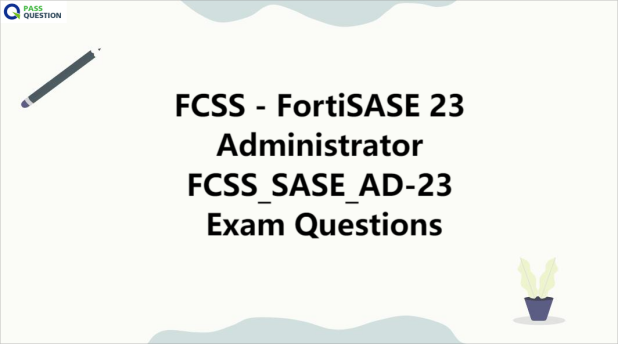FCSS - FortiSASE 23 Administrator FCSS_SASE_AD-23 Exam Questions
The FCSS_SASE_AD-23 FCSS - FortiSASE 23 Administrator exam is a critical part of the FCSS in SASE Certification process. To increase your chances of success and boost your confidence in the lead-up to the exam, we recommend using the latest FCSS - FortiSASE 23 Administrator FCSS_SASE_AD-23 Exam Questions from PassQuestion. The FCSS - FortiSASE 23 Administrator FCSS_SASE_AD-23 Exam Questions they provide are meticulously crafted based on the most recent syllabus and cover every single topic that you can expect to encounter on the FCSS_SASE_AD-23 exam. By utilizing these FCSS - FortiSASE 23 Administrator FCSS_SASE_AD-23 Exam Questions, you can approach your Fortinet FCSS_SASE_AD-23 exam with confidence, aiming to pass on your first attempt.

FCSS in SASE Certification Path
The FCSS in Secure Access Service Edge (SASE) certification validates your ability to design, administer, monitor, and troubleshoot Fortinet SASE solutions. This curriculum covers SASE infrastructures using advanced Fortinet solutions. We recommend this certification for cybersecurity professionals who require the expertise needed to design, manage, support, and analyze advanced Fortinet SASE solutions. To obtain the FCSS in SASE certification, you must pass the two core exams within two years. The certification will be active for two years from the date of the second exam.
Core Exams
FCSS - FortiSASE Administrator
NSE 7 SD-WAN
FCSS - FortiSASE 23 Administrator
FCSS - FortiSASE 23 Administrator exam is in the Fortinet Certified Solution Specalist - Secure Access Service Edge certification track. This certification validates your ability to design, administer, monitor, and troubleshoot Fortinet SASE solutions. The FCSS - FortiSASE 23 Administrator exam evaluates your knowledge of, and expertise with, the FortiSASE solution. The exam tests your applied knowledge of FortiSASE configuration and operation, and includes operational scenarios, incident analysis, integration with supported products, and troubleshooting scenarios. The FCSS - FortiSASE 23 Administrator exam is intended for network and security professionals who are responsible for designing, deploying, maintaining, and analyzing logs in a Fortinet SASE solution.
Exam Information
Exam name: FCSS - FortiSASE 23 Administrator
Exam series: FCSS_SASE_AD-23
Time allowed: 60 minutes
Exam questions: 30 multiple-choice questions
Scoring Pass or fail. A score report is available from your Pearson VUE account.
Language: English
Product version: FortiSASE 23.2, FortiOS 7.2, FortiClient 7.0, FortiAuthenticator 6.5
FCSS_SASE_AD-23 Exam Objectives
SASE architecture and components
- Integrate FortiSASE in a hybrid network
- Identify FortiSASE components
- Construct FortiSASE deployment cases
SASE deployment
- Implement various types of user onboarding methods
- Configure SASE administration settings
- Configure and apply security posture checks and compliance rules
SIA, SSA, and SPA
- Design security profiles to perform content inspection
- Deploy SD-WAN using FortiSASE
- Deploy ZTNA
Analytics
- Identify potential security threats using FortiSASE logs
- Configure dashboards, FortiView and logging settings
- Analyze reports for user traffic and security issues
View Online FCSS - FortiSASE 23 Administrator FCSS_SASE_AD-23 Free Questions
1. When using Secure Private Access (SPA) and SD-WAN, which protocol is used for spoke-to-spoke connectivity?
A. eBGP
B. SSL
C. IPSEC
D. GRE
Answer: C
2. Which FortiSASE Secure Private Access (SPA) deployment involves installing FortiClient on remote endpoints?
A. MicroBranch
B. zero trust network access (ZTNA)
C. secure web gateway (SWG)
D. SD-WAN
Answer: B
3. A customer has an existing network that needs access to a secure application on the cloud. Which FortiSASE feature can the customer use to provide secure Software-as-a-Service (SaaS) access?
A. secure web gateway (SWG)
B. zero trust network access (ZTNA)
C. SD-WAN
D. inline-CASB
Answer: D
4. Which FortiSASE feature can you use to see a list of Software-as-a-Service (SaaS) applications and health-check metrics for first-mile connectivity between the geographical points of presence (PoPs) provisioned for your FortiSASE instance and these SaaS applications?
A. event logs
B. digital experience monitoring DEM
C. FortiView
D. security logs
Answer: B
5. For FortiSASE point of presence (POP) to connect as a spoke, which Fortinet solution is required as standalone IPSec VPN hub?
A. secure web gateway (SWG)
B. SD-WAN
C. next generation firewall (NGFW)
D. zero trust network access (ZTNA)
Answer: C
6. Which FortiSASE component can be utilized for endpoint compliance?
A. Firewall-as-a-Service (FWaaS)
B. zero trust network access (ZTNA)
C. cloud access security broker (CASB)
D. secure web gateway (SWG)
Answer: B
7. FortiSASE delivers a converged networking and security solution. Which two features help with integrating FortiSASE into an existing network? (Choose two.)
A. SD-WAN
B. remote browser isolation (RBI)
C. security, orchestration, automation, and response (SOAR)
D. zero trust network access (ZTNA)
Answer: A, D
8. Which endpoint functionality can you configure using FortiSASE?
A. You can configure inline sandbox to scan zero-day malware attacks.
B. You can enable and push web filter to FortiClient endpoints.
C. It can be applied to both SWG and VPN deployments.
D. Site-based FortiExtender users can perform on-demand vulnerability scans.
Answer: A
9. How does integrating endpoint detection and response (EDR) systems into SASE contribute to security posture?
A. It serves as the primary firewall
B. It enhances user interface designs
C. It isolates the network from the internet
D. It provides real-time threat detection and response at endpoints
Answer: D
10. Which three ways does FortiSASE provide Secure Private Access (SPA) to corporate, non-web applications? (Choose three.)
A. Using SD-WAN technology
B. Using secure web gateway (SWG)
C. Using zero trust network access (ZTNA) technology
D. Using digital experience monitoring
E. Using next generation firewall (NGFW)
Answer: A, C, E
- TOP 50 Exam Questions
-
Exam
All copyrights reserved 2025 PassQuestion NETWORK CO.,LIMITED. All Rights Reserved.

